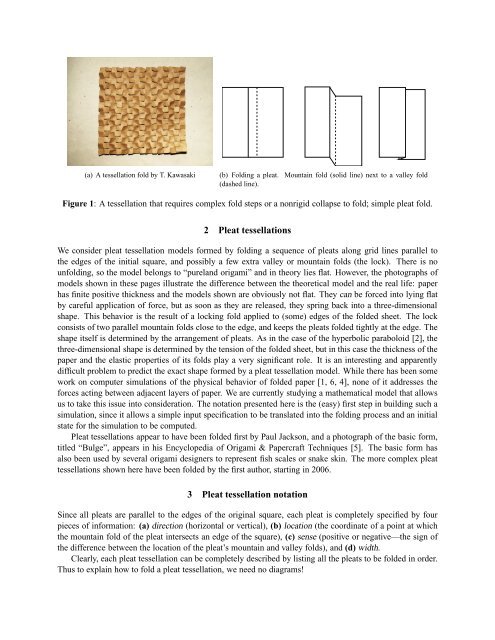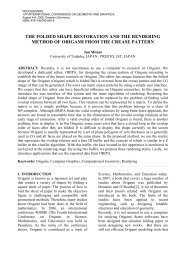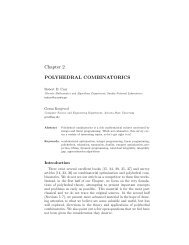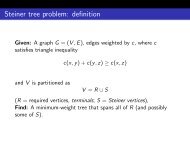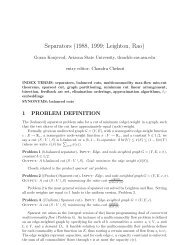Notation for a class of paperfolded models - Organic Origami
Notation for a class of paperfolded models - Organic Origami
Notation for a class of paperfolded models - Organic Origami
You also want an ePaper? Increase the reach of your titles
YUMPU automatically turns print PDFs into web optimized ePapers that Google loves.
(a) A tessellation fold by T. Kawasaki (b) Folding a pleat. Mountain fold (solid line) next to a valley fold<br />
(dashed line).<br />
Figure 1: A tessellation that requires complex fold steps or a nonrigid collapse to fold; simple pleat fold.<br />
2 Pleat tessellations<br />
We consider pleat tessellation <strong>models</strong> <strong>for</strong>med by folding a sequence <strong>of</strong> pleats along grid lines parallel to<br />
the edges <strong>of</strong> the initial square, and possibly a few extra valley or mountain folds (the lock). There is no<br />
unfolding, so the model belongs to “pureland origami” and in theory lies flat. However, the photographs <strong>of</strong><br />
<strong>models</strong> shown in these pages illustrate the difference between the theoretical model and the real life: paper<br />
has finite positive thickness and the <strong>models</strong> shown are obviously not flat. They can be <strong>for</strong>ced into lying flat<br />
by careful application <strong>of</strong> <strong>for</strong>ce, but as soon as they are released, they spring back into a three-dimensional<br />
shape. This behavior is the result <strong>of</strong> a locking fold applied to (some) edges <strong>of</strong> the folded sheet. The lock<br />
consists <strong>of</strong> two parallel mountain folds close to the edge, and keeps the pleats folded tightly at the edge. The<br />
shape itself is determined by the arrangement <strong>of</strong> pleats. As in the case <strong>of</strong> the hyperbolic paraboloid [2], the<br />
three-dimensional shape is determined by the tension <strong>of</strong> the folded sheet, but in this case the thickness <strong>of</strong> the<br />
paper and the elastic properties <strong>of</strong> its folds play a very significant role. It is an interesting and apparently<br />
difficult problem to predict the exact shape <strong>for</strong>med by a pleat tessellation model. While there has been some<br />
work on computer simulations <strong>of</strong> the physical behavior <strong>of</strong> folded paper [1, 6, 4], none <strong>of</strong> it addresses the<br />
<strong>for</strong>ces acting between adjacent layers <strong>of</strong> paper. We are currently studying a mathematical model that allows<br />
us to take this issue into consideration. The notation presented here is the (easy) first step in building such a<br />
simulation, since it allows a simple input specification to be translated into the folding process and an initial<br />
state <strong>for</strong> the simulation to be computed.<br />
Pleat tessellations appear to have been folded first by Paul Jackson, and a photograph <strong>of</strong> the basic <strong>for</strong>m,<br />
titled “Bulge”, appears in his Encyclopedia <strong>of</strong> <strong>Origami</strong> & Papercraft Techniques [5]. The basic <strong>for</strong>m has<br />
also been used by several origami designers to represent fish scales or snake skin. The more complex pleat<br />
tessellations shown here have been folded by the first author, starting in 2006.<br />
3 Pleat tessellation notation<br />
Since all pleats are parallel to the edges <strong>of</strong> the original square, each pleat is completely specified by four<br />
pieces <strong>of</strong> in<strong>for</strong>mation: (a) direction (horizontal or vertical), (b) location (the coordinate <strong>of</strong> a point at which<br />
the mountain fold <strong>of</strong> the pleat intersects an edge <strong>of</strong> the square), (c) sense (positive or negative—the sign <strong>of</strong><br />
the difference between the location <strong>of</strong> the pleat’s mountain and valley folds), and (d) width.<br />
Clearly, each pleat tessellation can be completely described by listing all the pleats to be folded in order.<br />
Thus to explain how to fold a pleat tessellation, we need no diagrams!


